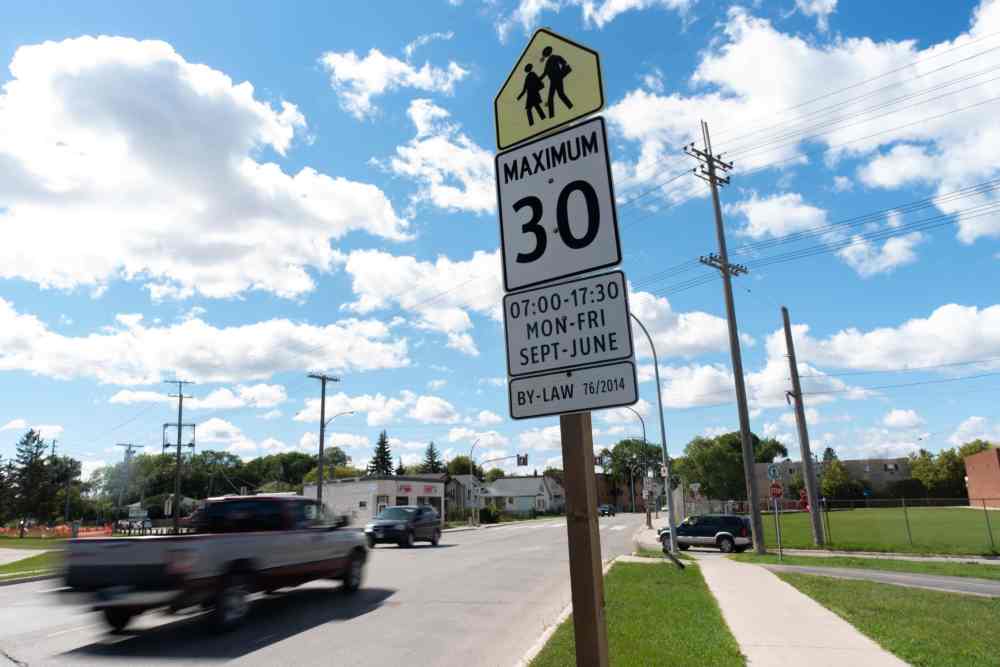Study urges traffic changes in school zones
Advertisement
Read this article for free:
or
Already have an account? Log in here »
To continue reading, please subscribe:
Monthly Digital Subscription
$0 for the first 4 weeks*
- Enjoy unlimited reading on winnipegfreepress.com
- Read the E-Edition, our digital replica newspaper
- Access News Break, our award-winning app
- Play interactive puzzles
*No charge for 4 weeks then price increases to the regular rate of $19.95 plus GST every four weeks. Offer available to new and qualified returning subscribers only. Cancel any time.
Monthly Digital Subscription
$4.99/week*
- Enjoy unlimited reading on winnipegfreepress.com
- Read the E-Edition, our digital replica newspaper
- Access News Break, our award-winning app
- Play interactive puzzles
*Billed as $19.95 plus GST every four weeks. Cancel any time.
To continue reading, please subscribe:
Add Free Press access to your Brandon Sun subscription for only an additional
$1 for the first 4 weeks*
*Your next subscription payment will increase by $1.00 and you will be charged $16.99 plus GST for four weeks. After four weeks, your payment will increase to $23.99 plus GST every four weeks.
Read unlimited articles for free today:
or
Already have an account? Log in here »
Hey there, time traveller!
This article was published 28/08/2020 (1959 days ago), so information in it may no longer be current.
A report on school zone speeding in the East Kildonan-Transcona area has prompted the city’s public works department to make recommendations to get more drivers to obey school-zone speed limits.
Tasked with investigating speed violations in the neighbourhood, the city department delivered a report to the East Kildonan-Transcona Community Committee, which found a total 11,195 tickets were issued in the neighbourhood’s reduced speed school zones in 2018.
The majority of tickets were issued through photo enforcement while 237 were issued through traditional police enforcement. Of the photo enforcement tickets, more than 90 per cent came from reduced speed zones at three schools: River Elm with 6,390 tickets, The King’s School with 2,276 tickets and Ecole Riviere Rouge, where 1,367 tickets were issued.

The report recommends expanding school zones beyond streets immediately bordering schools to ensure all parents and children within the 1.6 km walking zone of the school have access to safe streets, increasing the 30 km/h rules to a 24-hour, seven-days a week schedule to reduce confusion around holidays and evenings, and expanding school zones to middle and high schools.
It also recommended removing the requirement that school zones be implemented on non-regional streets in favour of a policy based on road classification, fencing, pedestrian and cycling infrastructure and other factors.
Also, it recommended following the City of Calgary in implementing reduced-speed zones near public playgrounds.
There are currently 240 reduced speed school zones throughout Winnipeg. These zones have a maximum speed of 30 km/h and are currently in effect from 7 a.m. to 5:30 p.m. Monday to Friday from September to June.
In an email statement Friday, Winnipeg Police Service said “reduced speed school zones throughout the city see fluctuations and variances in detected offences.” Though the study was only conducted for the East Kildonan-Transcona neighborhood, the city confirmed a wider study on road safety strategies is underway, and will review reduced speed school zones efficacy in other areas of the city.
Despite high levels of infractions in some school zones, police data found motorists generally reduce speeds to comply with school zones, and typically drive below the 50 km/h limit in effect during non-school hours.
Feedback from six school districts in the city overwhelmingly indicated that the reduced speed school zones improve student safety, according to the report.
Further evidence from a study conducted in Edmonton found that reducing speeds from 50 km/h to 30 km/h resulted in a 45 per cent reduction in fatal and non-fatal injury collisions and a 55 per cent reduction in injuries to vulnerable road users. For every one km/h reduction in average speed, fatal and non-fatal injury collisions dropped by four per cent, the study found.
The report comes in the midst of other municipal investigations into street safety measures, including a possible 30 km/h speed limit on all residential streets. If this limit were to come into play, reduced speed school zones may not be necessary, the report said.
julia-simone.rutgers@freepress.mb.ca
Twitter: @jsrutgers

Julia-Simone Rutgers is the Manitoba environment reporter for the Free Press and The Narwhal. She joined the Free Press in 2020, after completing a journalism degree at the University of King’s College in Halifax, and took on the environment beat in 2022. Read more about Julia-Simone.
Julia-Simone’s role is part of a partnership with The Narwhal, funded by the Winnipeg Foundation. Every piece of reporting Julia-Simone produces is reviewed by an editing team before it is posted online or published in print — part of the Free Press‘s tradition, since 1872, of producing reliable independent journalism. Read more about Free Press’s history and mandate, and learn how our newsroom operates.
Our newsroom depends on a growing audience of readers to power our journalism. If you are not a paid reader, please consider becoming a subscriber.
Our newsroom depends on its audience of readers to power our journalism. Thank you for your support.


